3 May 2004
Bonaire N12.0957 W068.1694
Rincon Day
The islands we visited in Venezuela enroute to Bonaire, now have restrictions on taking conch and turtle. Conch shells are piled twenty feet high in some locations as monuments to the past decimation of this gastropod. The shallow grass lined pools where conch like to gather are now for the most part empty but the species does flourish in more remote locations. Conch are easy to capture since they move only a few feet per day by dragging their heavy shell with a single appendage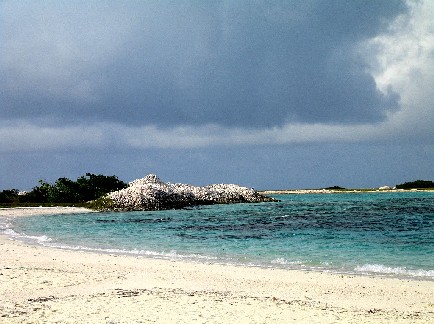 . But it's not the chase that makes these bipods interesting prey, rather its the preparation. To prepare a conch you must first be sure it is of the right handed variety. Left handed conch are very rare and being so are very valuable so you don't want to ruin the shell. Once you figure that out, you make a "slit" on the second row of the spirals that create the crown of the conch. This "slit" is made with a mineral hammer or a hammer and chisel. With either tool it is a great opportunity to remove a considerable amount of gel coat from the bottom of your cockpit or if your so inclined to ruin a good coat of bright work on the teak. This hint should tell you that this work is best done ashore. The older the conch the thicker the shell so if at all possible pick a good size one but with a thinner shell.. After the "slit" is made, insert a flexible knife to cut the muscle that attaches the animal to the shell. If this is done in a timely manner the conch will not slime on you and will easily slide out of it's shell. I understand that even a brain surgeon doesn't get it without a lot of practice. Now that you have the muscle out of the shell it is best to let it sit in salt water for an hour or so in order for it to succumb and therefore relax. There is also a technique that requires putting the whole conch in the freezer for a day or two in order to get it to release from the shell but this takes up a lot of space in a boat freezer. . But it's not the chase that makes these bipods interesting prey, rather its the preparation. To prepare a conch you must first be sure it is of the right handed variety. Left handed conch are very rare and being so are very valuable so you don't want to ruin the shell. Once you figure that out, you make a "slit" on the second row of the spirals that create the crown of the conch. This "slit" is made with a mineral hammer or a hammer and chisel. With either tool it is a great opportunity to remove a considerable amount of gel coat from the bottom of your cockpit or if your so inclined to ruin a good coat of bright work on the teak. This hint should tell you that this work is best done ashore. The older the conch the thicker the shell so if at all possible pick a good size one but with a thinner shell.. After the "slit" is made, insert a flexible knife to cut the muscle that attaches the animal to the shell. If this is done in a timely manner the conch will not slime on you and will easily slide out of it's shell. I understand that even a brain surgeon doesn't get it without a lot of practice. Now that you have the muscle out of the shell it is best to let it sit in salt water for an hour or so in order for it to succumb and therefore relax. There is also a technique that requires putting the whole conch in the freezer for a day or two in order to get it to release from the shell but this takes up a lot of space in a boat freezer.
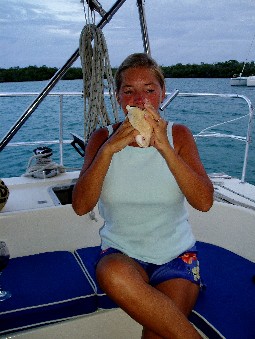
The next step is to skin the muscle and cut off all the parts that can be identified as inedible. In doing so keep an eye out for a pearl the some conch have in their internal organs. It can be worth up to $1000. You will now have a piece of a marine gastropod that is a tough as shoe leather and if you still consider eating it you must pound it with a meat tenderizer until you inflict carpal tunnel syndrome on you wrist. Next marinate in a little lime juice and enjoy it in a salad with oil and vinegar. You have just expended 1600 calories to take in 300. In Bonaire conch is available in the grocery store so it is still a commercial product in several parts of the world. As a side benefit of cleaning a conch you can try and make a musical instrument out of its beautiful pink shell. Since 8000 BC aspiring musicians have irritated the hell out of surrounding villagers and family members by practicing on this precursor of the trumpet. Rene' has now become a virtual concertinosist on the conch.
The boat is now moored in Bonaire only fifty feet from the shore and the bow sits in water that is 15 feet deep and the stern in 40 feet. Not since I swam in deserted stone quarries in my youth, have I seen water so clear. The shades of blue typically depict depth but it is not necessarily so in Bonaire here since you can look straight down and see the coral at forty feet. In our first walk around town we found that along the shore parrot fish swim in water so shallow that their tails sticking out. This small island of the Netherlands Antilles is gaining a reputation for eco-tourism and everything is focused on the environment and keeping the water clean. Scuba diving is the main focus of the tourists industry since there few beaches and to protect the marine life you must turn in any spears or spear guns upon arrival.
The island is very arid and most of the vegetation is made up of cacti and a type of scrub tree that by its shape makes it easy to tell which direction is windward. The rugged terrain of rock ledges and sand looks a bit like Arizona and the 400 or so donkeys roam free. During the day they can be found in the countryside and late at night they come into town and crap all over the streets. I am not certain why but I like to think it is because they can. The island was "discovered" by Amerigo Vespucci in 1499 or 1500 and eventually was occupied by the Spanish. The Spanish gave up the ABC's in the 1500's since th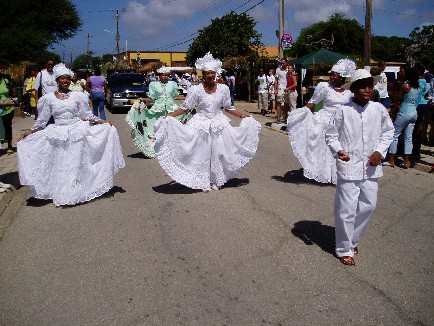 ere was no gold and agriculture was unproductive. The Dutch occupied the islands in 1636 in order to process salt since they were at war with Portugal and Spain the worlds primary sources of salt at the time. Even today the production of course salt accounts for 20% of the GDP. Eventually slave trading became the primary commercial activity as the Dutch supplied the South American markets via these tiny outpost. ere was no gold and agriculture was unproductive. The Dutch occupied the islands in 1636 in order to process salt since they were at war with Portugal and Spain the worlds primary sources of salt at the time. Even today the production of course salt accounts for 20% of the GDP. Eventually slave trading became the primary commercial activity as the Dutch supplied the South American markets via these tiny outpost.
On the 30th of April the island celebrated Rincon Day. Rincon is a small village (4000 inhabitants) located near the center of the island and for weeks every rent a car, scooter and motor cycle has been reserved for the weekend and taxis are booked to the limit. People from Aruba, Curacao and Venezuela come for the weekend to enjoy the celebration and they are accompanied by the tourists on the island and most all the locals. Every business closes down for the entire weekend. Fortunately we were offered a ride to Rincon by one of the marine park officers who lives there and so not only did we get the ride but most important we gathered some local knowledge. This holiday appears to be more of a founders day celebration with people in original costume singing original island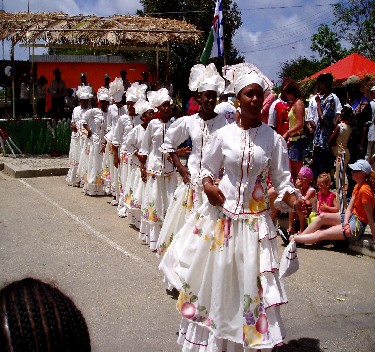 music but we were told it is in celebration of a good harvest (today that means a good harvest of tourists). Incorporated into the Rincon celebration is the Queen's birthday and May Day. The village itself is about three square blocks and at strategic locations throughout musical groups in native dress play and sing and dance. There may be three or four groups going at the same time and several times during the day a parade marches down the main thoroughfare. A wide array of food stands sponsored by all the local civic organizations, churches, restaurants and entrepreneurs offer barbeque chicken, ribs and pork and you can wash it all down with those great Dutch beers. music but we were told it is in celebration of a good harvest (today that means a good harvest of tourists). Incorporated into the Rincon celebration is the Queen's birthday and May Day. The village itself is about three square blocks and at strategic locations throughout musical groups in native dress play and sing and dance. There may be three or four groups going at the same time and several times during the day a parade marches down the main thoroughfare. A wide array of food stands sponsored by all the local civic organizations, churches, restaurants and entrepreneurs offer barbeque chicken, ribs and pork and you can wash it all down with those great Dutch beers.
Local artisans also man booths and you walk around the village listening to the music and eating. The local language, Papiamentu is a type of Spanish Creole with a great deal of Dutch which is the language used in schools. Everyone we met could also speak English.
We are working on our watermaker which hasn't worked in six weeks and we have parts on order from the manufacture. The apparatus is not that difficult since it is basically a series of motors, pumps and gages. The technology is encapsulated in the Dow membrane which has an average life of five years. Ours is now 10 years old so we have a new one on order.
There is a Budget Marine in Bonaire an we are anxious to purchase items we have been postponing and there may be the opportunity to repair our onboard computer that has given us trouble as of late. The hard drive failed and we were unable to save any of the information and without a read-write we don't have a good backup. It sounds simple enough to reload all the programs but the integration of e-mail, radar, gps, ssb radio, weather fax, two screens, two mice, printer, scanner, etc., make it a challenge. Rene' is able to accomplish all this with little or no cussing.
On a more important matter let us up date you on our sons serving in the military. Judson has returned from Iraqi with the 4th Division and is now stationed in Fort Hood, Texas. And days before his return Josh departed Fort Hood for Iraqi with the 1st Cav. So one in and one out without a days respite.
12 May 2004
Bonaire N12.0957 W068.1694
Sea Hunt 2004
In 1992 I convinced Rene that we should become certified scuba divers. It took some doing but we were recently married and she wanted to please. I had in my mind that one day we would take a tropical vacation and it would be wonderful to be able to see what was below the water as well as above. We enrolled with one of the local dive shops and the preliminary work was done in the pool of a local high school. The mandatory open water dives were made in the murky quarries around Ft. Wayne and what we both remember was that it was very cold, the water was the color of tea with a little milk and all we saw was one lousy crappie and an ugly looking catfish. Nothing in the course instilled us with the desire to go out and rent equipment the next weekend.
Ten years later and no dives in between, we showed up at a dive shop with our PADI certification cards in hand and bought all the latest equipment in preparation for the slackadventure. In the intervening ten years we had lived in Connecticut and California and could have enjoyed scuba in either location but we were into skiing and our vacations and weekends were focused on slalom not scuba. After 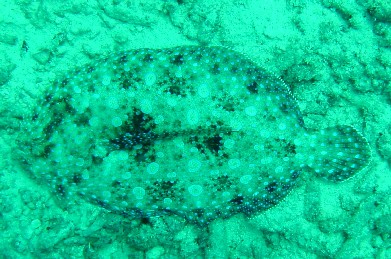 reading the manuals that came with the equipment and a refresher in the swimming pool , we were off to the stone quarries around Indianapolis. Diving in theses quarries, we found the water to be much clearer and one hell of a lot colder since we were trying to go a little deeper. By the end of thirty or forty minutes our lips were blue and our hands were wrinkled and white. This was the signal it was time to go home no matter how much air we had left in the tanks. Well, hell two or three dives and we were ready to take on the Caribbean. Ready that is to pack away the gear in the bottom of the boat for a year. In Bequia we took our first saltwater dive. Our Bequia experience was a bit deflating since I couldn't get the dive computer attached to the octopus. It was under pressure and I needed to relieve the pressure in order to couple the units. Next I put the three legged contraption on upside down according to the dive instructor who took it off and put it on correctly without saying a word. Well it worked in the quarries why change a good thing. You just knew that this young lady was going to keep an eye on us after these screw ups but that was okay as we needed a little extra attention. We had a great dive and were anxious to go out again but instead we stowed the gear away and moved on. Venezuela was no better, plenty of opportunity but no motivation. reading the manuals that came with the equipment and a refresher in the swimming pool , we were off to the stone quarries around Indianapolis. Diving in theses quarries, we found the water to be much clearer and one hell of a lot colder since we were trying to go a little deeper. By the end of thirty or forty minutes our lips were blue and our hands were wrinkled and white. This was the signal it was time to go home no matter how much air we had left in the tanks. Well, hell two or three dives and we were ready to take on the Caribbean. Ready that is to pack away the gear in the bottom of the boat for a year. In Bequia we took our first saltwater dive. Our Bequia experience was a bit deflating since I couldn't get the dive computer attached to the octopus. It was under pressure and I needed to relieve the pressure in order to couple the units. Next I put the three legged contraption on upside down according to the dive instructor who took it off and put it on correctly without saying a word. Well it worked in the quarries why change a good thing. You just knew that this young lady was going to keep an eye on us after these screw ups but that was okay as we needed a little extra attention. We had a great dive and were anxious to go out again but instead we stowed the gear away and moved on. Venezuela was no better, plenty of opportunity but no motivation.
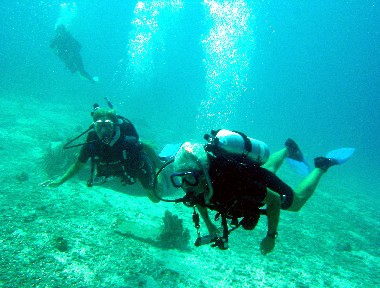
With Bonaire ranked as the best dive spot in the world according to some dive magazines, it was inevitable that we pull out our tanks and douse them again in salt water. Only this time we are going to commit some time and effort to the endeavor. Our first dive was a familiarization dive below our boat. We read the manuals and especially the one on the computer. We purchased these expensive dive computers that tell you everything about all the dives you ever made and monitor all your activities under the water as well as above (i.e. how long you should wait before you fly). They start recording when you go below four feet so they missed some information on Rene's quarry dives. The computer gives visual and audible signals when you have done something wrong. Yea like I'm going to hear an audible signal underwater. Thankfully I have Rene along to elbow me in the ribs if a signal does go off. Actually we haven't yet gone deep enough or for long enough to have an alarm go off with the exception of an alarm that Rene occasionally activates that tells her that she is breathing too fast, a natural reaction when learning to relax and enjoy the new surroundings.
I dropped a weight belt on a line over the side just in case we needed a few extra pounds to reach neutral bouncy and we slipped into the water below the boat to check out the equipment and the people wearing the equipment . Right below our boat there were several school of large yellow fin snapper and grouper. These are the largest fish we have seen under water with the exception of an occasional barracuda. Our dive plan was to head a bit up current until our tanks reached 1800 psi and then to return to the boat. Our confidence grew as we made the up current swim we started going a little deeper passing the other boats that were moored down the line. We turned and headed back to our boat and drifted into deeper water stopping at 70 feet. The coral behind the boats started to glow in brilliant colors as the sun came from behind the clouds and lit the ocean floor. We had seen Christmas coral in Venezuela with its poinsettia red and brilliant greens but this was more colorful. Tubular coral in lavender, brain coral in pale green, stag horn in orange, fire coral in pink, fan goral in shades of purple and brown. Sea Hunt never looked like this on our old black and white TV.
When we finished we were anxious to return and take another look.
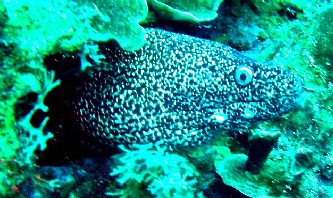
Several nights ago I saw bright green lights below Shiraz as scuba divers were making their way along the bottom. Their bubbles make a hell of a lot of noise on the bottom of the boat but now we have become accustom to the sound and don't jump to see what's wrong. We went to the Old Inn restaurant to attend a "fish ID" class given by one of the locals every Tuesday. The topic that night seemed to be "the mating habits of fish" which usually occurrs in the early morning and late evening, so that gives us an incentive to do an early morning dive and a night dive. It is also feeding time so there is a flurry of activity, different than normal daytime activities. While at the Old Inn we enjoyed a dish they are famous for called Rijsttafel. This is exotic Indonesian cuisine so we enjoyed dishes such as Soato Ajam, Nasi Goreng, Bami, Ajam Smoor, Ikan Atjar, Gado Gado, Sambal Tomat, Nasi Puti, Ketimoen Tomat, and other selections of sweet and moderately spicy dishes.
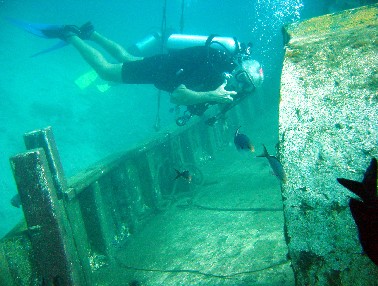
Before our second dive we had already signed up for 50 refills meaning we thought we would make 25 dives before we left Bonaire. On the next dive we were joined by friends from 5th Season and Sojourner and went down to 90 feet. Now that's not that deep and we are not trying to break any records, personal or otherwise it is just that things are so interesting that you find yourself drawn into the experience. Soon we were given directions to a 60 foot "wreck" not a half a mile from out boat and on this dive we found ourselves in 100 feet of water as we crossed the marina entrance to get to the wreck.
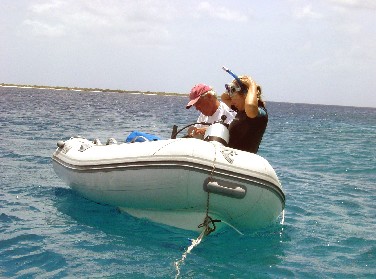
Diving is enjoyable but it is an equipment intensive sport. That means that you must become very familiar with your equipment and learn to trust it's reliability. Underwater it is weightless as you are able to adjust you BC or buoyancy compensator by filling it with air or adding weight until you are neutral. But out of the water and it's a hell of a lot of pieces and pounds to haul around. Just trying to get all that stuff on in your dinghy is an exhausting challenge especially if you're the last dinghy of three that pulls up to the site and half of them are already in the water. First you put on your wetsuit which is black and before it's on you're sweating profusely. Then you assemble your tank, BC, regulator, computer and weights before you suffer from heat prostration. Now slip all this on, yea right. You can't stand up and to do it and you can't sit down since the seat is too low to be able to put your tank on. Finally sit on the edge of the dinghy and put on your fins and mask before your muscles start to cramp up and fall off into the water.
Lloyd Bridges slipped on his equipment, went to the bottom, fought off the bad guys and saved his unwitting companions in less time than it took for me to put on my equipment.
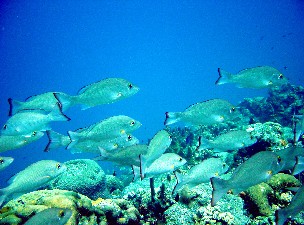
Underwater photography courtesy of our friends David and Gail aboard 5th Season II.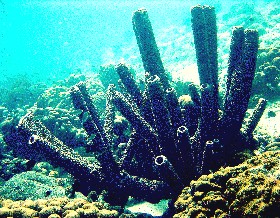
Back Next
|